My Hands-On Experience with Sobchak Security's "Obviously You're Not a Golfer" MOA Pack
Posted by Mandu Moses on Apr 11th 2025
Every once in a while, a piece of kit lands in my hands that just makes sense. Not flashy, not overengineered—just well-thought-out gear built by folks who clearly know the world of precision shooting. That’s exactly what I found when I got my hands on the “Obviously You’re Not a Golfer” MOA Pack from Sobchak Security.
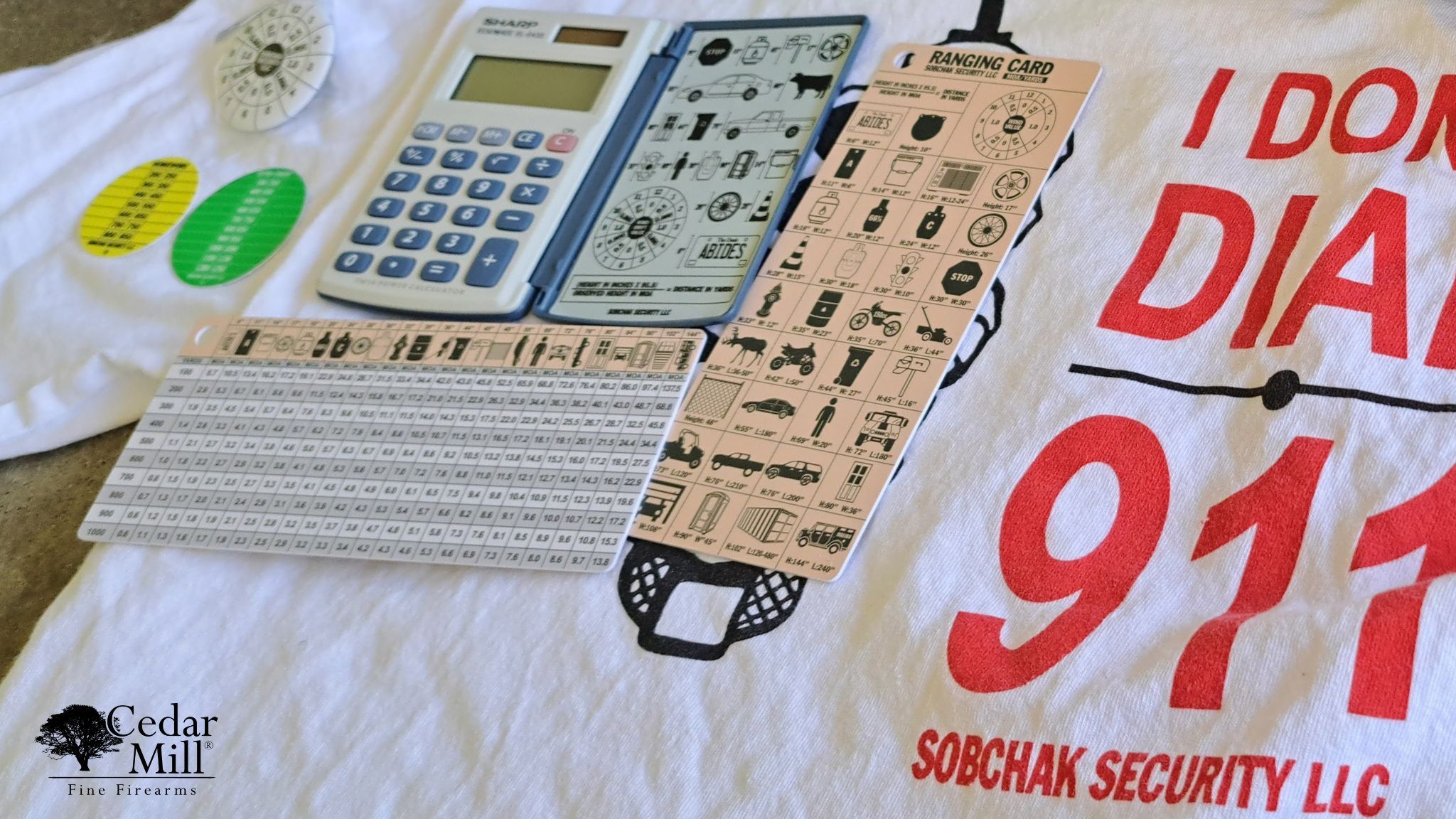
If you’re into long-range shooting or just looking to improve your range estimation and ballistic accuracy, this is one of those packs that earns a spot in your range bag—not your junk drawer.
First Impressions: What’s in the Pack?
When the package arrived, I wasn’t expecting much. But inside was a tight little bundle of tools that immediately felt more purpose-built than gimmicky.
My pack included:
- "Homework" & "Extra Credit" Scope Dope Sticker Packs: Multiple durable, matte-finish stickers designed to live inside your scope caps for instant ballistic data reference.
- North American Ranging Cards (x2): Two identical, robust plastic cards featuring common objects for MOA-based range estimation.
- Calculator with MOA Cheat Sheet: A simple, reliable Sharp calculator with a handy MOA formula sticker attached.
- Wind Pin: A small, simple tool to help visualize wind direction and hold.
Each item is designed for quick reference and field use—no fluff, just utility. From the moment I unpacked it, I could tell this gear was designed by someone who’s spent time behind glass, not just behind a computer screen.
Where You Can Grab One
You can pick up the “Obviously You’re Not a Golfer” MOA Pack directly through Sobchak Security’s website or through their Amazon storefront. At $55 with free U.S. shipping, it’s one of the more accessible upgrades you can add to your range workflow.
Also available in a MIL/Yards version if that’s your flavor.
Installation and Getting Started
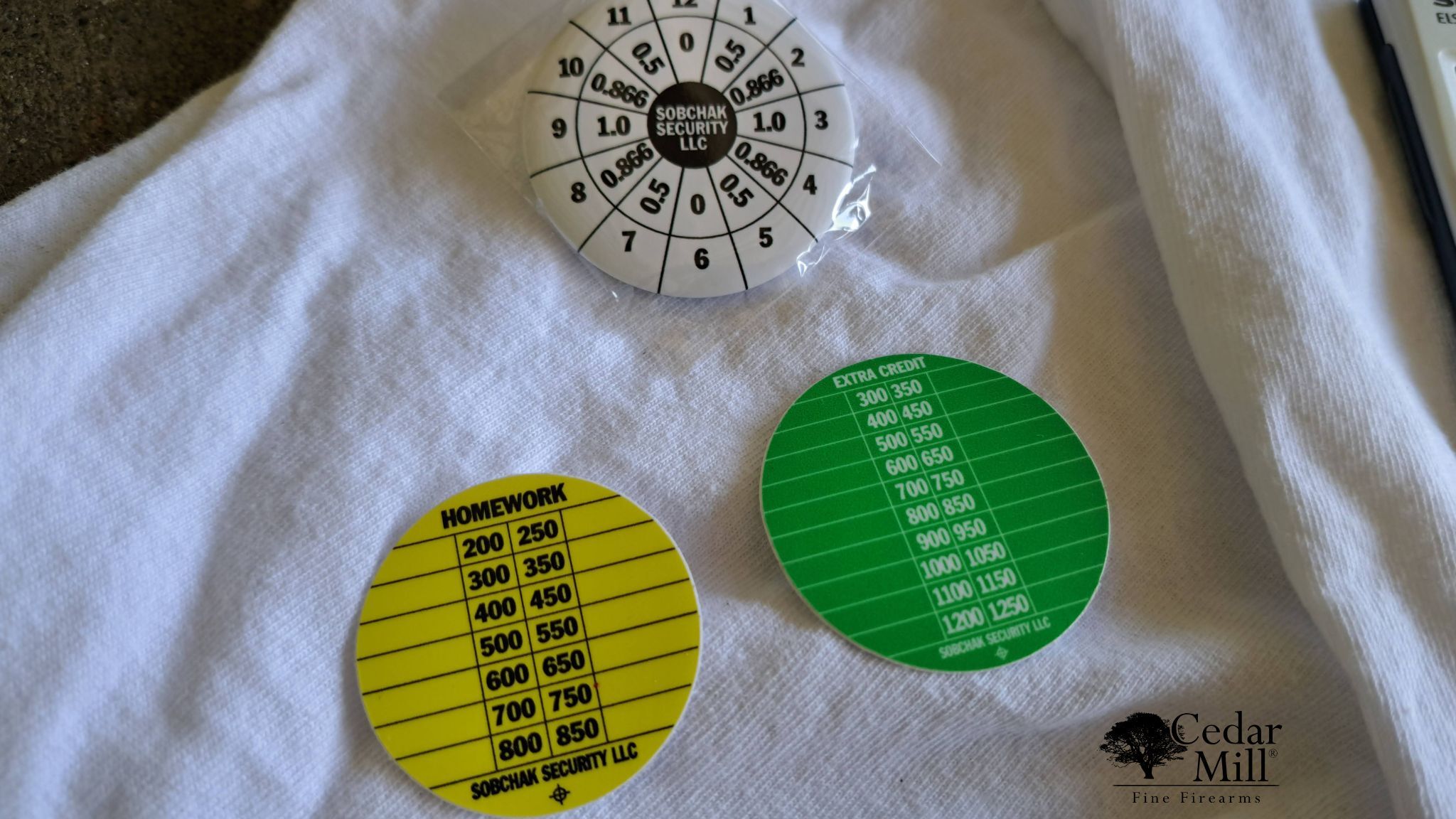
There’s no complex setup here, which is exactly what you want from field tools. The core idea is practical application:
- Scope Dope Stickers: These are arguably the heart of the quick-reference system. The pack includes two types – "Homework" (smaller, 1.5" diameter, 200-850 yards) and "Extra Credit" (larger, 1.7" diameter, better for longer ranges or bigger scope caps).
- Pro Tip: Definitely fill out your chosen sticker with your specific load data (using an extra-fine Sharpie for the laminated "Extra Credit" ones) before you try sticking it inside your scope cap. Trust me, writing neatly on a tiny, delicate, already-applied sticker is an exercise in frustration you don't need. Once filled, peel and press it onto the inside of your objective or ocular lens cap. Flip it open, and your dope is staring right back at you. Brilliant.
- Ranging Cards & Calculator: These are designed for your pocket, pouch, or lanyard. Keep them accessible. The goal is to quickly estimate target distance using the cards, crunch the numbers (if needed) with the calculator, factor in wind, and then glance at your scope cap sticker for the final elevation hold or dial.
The Components in Detail
The Scope Dope Stickers ("Homework" & "Extra Credit")
These aren't just any stickers. The "Homework" version, with its 50-yard increments from 200 to 850 yards, is perfect for my AR-15 setup or standard hunting rifle scopes. The matte finish takes pen or pencil well (though Sharpie is best for longevity) and reduces glare.
The larger, green "Extra Credit" sticker feels tailor-made for long-range rigs with bigger objective bells and the need for data potentially reaching out past 1000 yards (it has space for data from 300 up to around 1250). Having both sizes shows Sobchak understands that shooters often have different rifles for different purposes. It’s this kind of practical consideration that elevates the kit.
The North American Ranging Cards
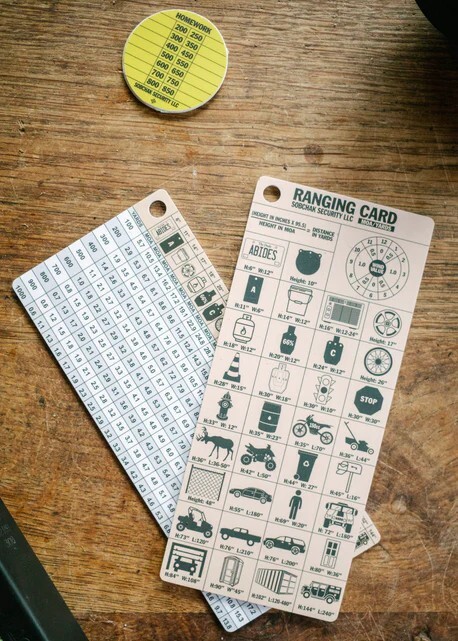
For me, these are potential game-changers, especially if you don't have a laser rangefinder or want a reliable backup. Made from a flexible but tough plastic (think credit card material, but larger at 6" x 2.625"), they feel like they'll survive being shoved into pockets or pouches repeatedly.
The real magic is the list of common objects found across North America and their standard dimensions (in inches). We're talking:
- License Plate (6" H x 12" W)
- Standard Bucket (14" H)
- Propane Tank (18" H)
- Traffic Cone (28" H)
- Steel Barrel (34" H)
- Whitetail Deer (Avg. 36-40" shoulder height)
- Stop Sign (30" Octagon)
- Standard Door (80" H)
- ...and many more (vehicles, farm equipment, etc.)
The process is straightforward MOA ranging: Frame the object in your reticle, measure its height or width in MOA, and plug it into the formula:
(Object Height in Inches × 95.5) ÷ MOA Reading = Range in Yards
Example: You measure a standard US license plate (6" tall) as filling 1.5 MOA in your scope.
(6 × 95.5) ÷ 1.5 = 573 ÷ 1.5 = 382 yards.
Now you know your distance. Flip to your scope dope sticker, find the 375 or 400-yard data, and adjust accordingly. The back of the card even has a handy matrix grid pre-calculating ranges for certain objects at specific MOA readings, saving you calculation time in the field.
The Calculator & Cheat Sheet
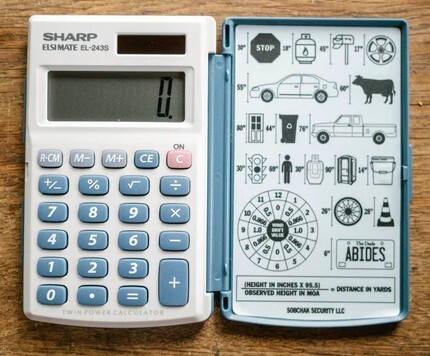
The included Sharp EL-243S calculator is basic, solar-powered (with battery backup), and has rubber keys and a hard cover. It's perfect. Why? Because it just works. No complex functions and no dead battery worries in the sun. It does addition, subtraction, multiplication, and division – exactly what you need for ballistics math.
Stuck right on it is a cheat sheet sticker summarizing the MOA ranging formula and providing a basic wind drift chart (e.g., MPH wind value x Range / 100 = MOA correction for full value wind). It keeps the essential math front and center.
The Wind Pin
A simple addition, this small pin helps visualize wind direction relative to your shooting position. Stick it in the ground or attach it to your gear. It's a low-tech but effective aid for judging wind holds.
Performance at the Range
Theory is great, but field use is where the rubber meets the road (or the bullet meets the steel). I took the Sobchak kit out on several range trips, deliberately leaving my laser rangefinder in the bag for some drills.
- Sticker Access: Having my dope right inside the scope cap is incredibly fast. Settle into position, flip open the cap, confirm the range, glance at the sticker, dial or hold, and shoot. It minimizes head movement and keeps you focused downrange.
- Ranging Practice: Using the cards to estimate distances to various steel targets and natural objects became a useful skill-building exercise. It's not as precise as a laser, naturally, but for practical field shooting or as a backup, it's surprisingly effective once you get the hang of accurately measuring objects in your reticle. I found myself getting within 5-10% of the actual range consistently after a bit of practice.
- Combined Workflow: Spot target → Estimate range with card → Quick calculation on the solar calculator (if needed) → Check scope sticker for drop/wind → Send it. The system flows logically.
- Durability: The cards held up to being handled with dusty gloves, and the stickers stayed firmly put inside the caps, even on hot days. The calculator just kept working.
How It All Performs at the Range

I took the full pack with me on a 400-yard range session, and the utility showed immediately. The Homework sticker on my Riton Conquer 5 cap gave me dead-simple drop data. The Extra Credit sticker went on my bolt gun’s optic, where longer ranges called for more granular inputs.
Using the ranging card, I would estimate a barrel at 400 yards. That’s close enough to count when you're dialing wind in shifting conditions.
The calculator? Did exactly what it was supposed to do. No batteries to worry about and no bloaty features. Just quick math and a reliable dope reference.
Pros
- Highly Practical: This isn't just cool-looking gear; it directly addresses core needs in precision shooting.
- Intuitive System: The components work together seamlessly, speeding up the shooting process.
- Instant Dope Reference: The scope stickers are genius for quick data access.
- Effective Ranging Backup: The cards provide a reliable non-electronic method for estimating distance.
- Quality Materials: Durable plastic cards, quality adhesive stickers, and a reliable calculator.
- Thoughtful Details: Different sticker sizes, common objects on cards, a simple calculator – it shows a shooter-centric design.
- Fair Price: Considering the utility and quality of the bundled items, the $55 price point feels reasonable.
What Could Be Better
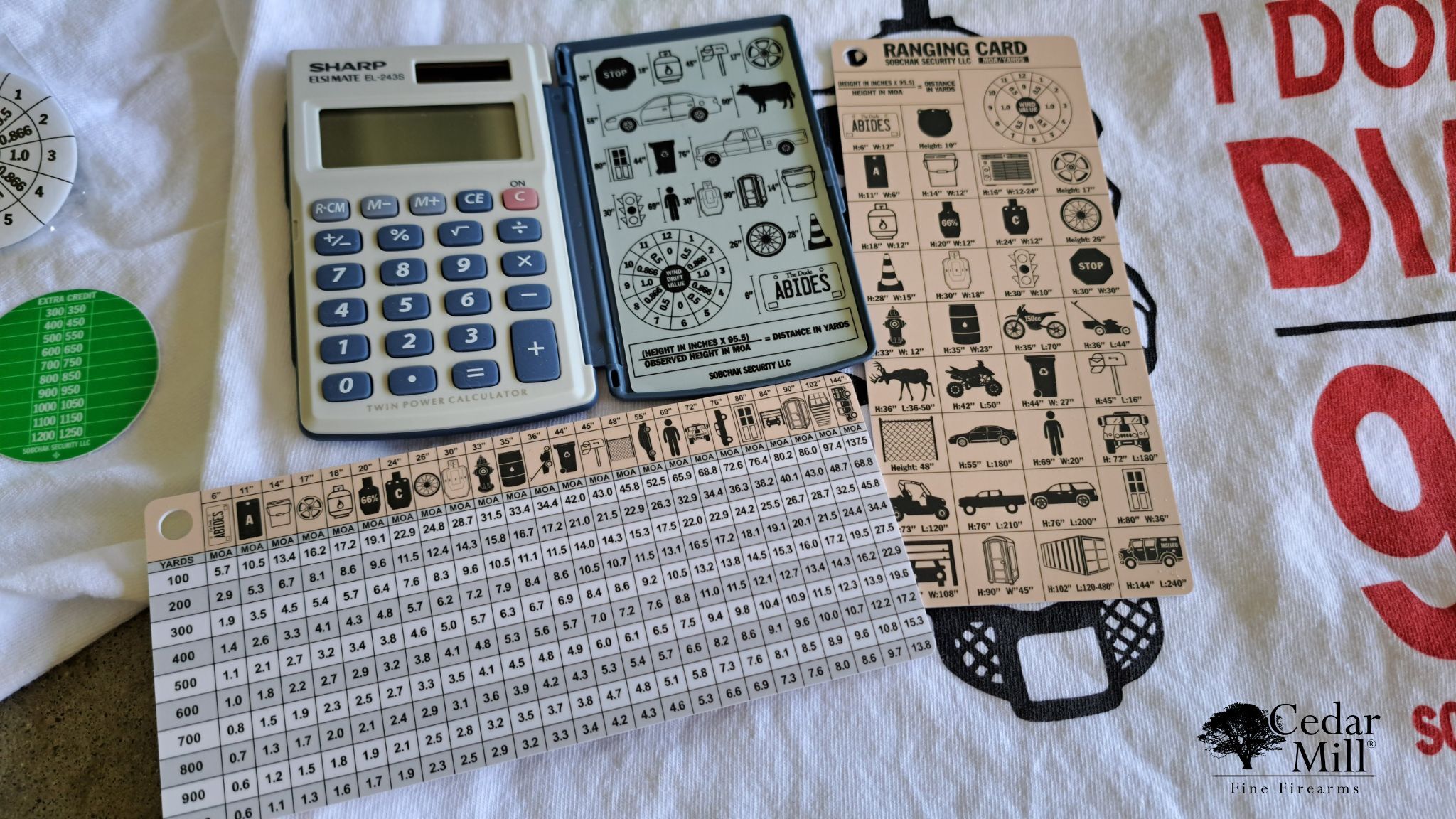
The only suggestion I’d toss out is making different sets of objects on the two ranging cards. Right now, they’re identical—great for backups, but it would’ve been nice to have a little more variety to extend the application.
Still, not a dealbreaker by any stretch.
Final Verdict
The Sobchak Security “Obviously You’re Not a Golfer” MOA Pack is easily one of the most underrated shooting tools I’ve used in recent months. If you’re a precision shooter, a competition guy, or just someone who likes to get nerdy with your ballistic data, this is a kit worth owning.
It strips away the need to rely on apps or scribbled notes and gives you durable, intuitive tools you’ll actually use.
Whether you’re on a range day, at a PRS match, or just working on fundamentals in your backyard setup, this pack earns its spot every time.
Recommended For: Precision rifle shooters, hunters, tactical marksmen, PRS competitors, and weekend warriors who want reliable, low-profile ballistic reference tools.
If you’ve seen these stickers pop up in shooter content across YouTube gun channels like Dirty Civilian or IG, yes, they really are that handy. Props to Sobchak for building gear that works as hard as we do.
Related Blog: Understanding MOA and MILS: A Comprehensive Guide to Precision Shooting Measurements
